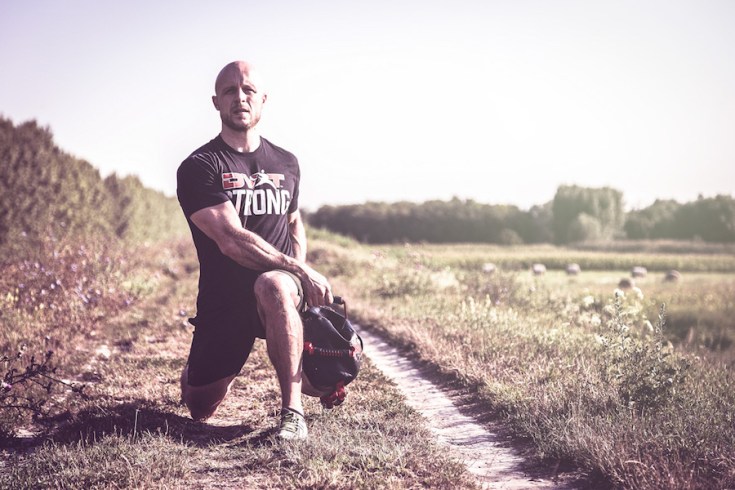Using DVRT to Change Our Fitness Workouts
2018-11-15
Greg Perlaki, DVRT Master, Creator of DVRT Dynamic Warm-ups & DVRT UK

So many times people think that DVRT can be overwhelming. Follow the posts Josh and Jessica make along with so many of our DVRT Masters team, it won’t be long till your head is spinning. Fortunately, I was able to see how simple things could be when I had the exciting ability to teach my first DVRT workshop here in England. That experience made me want to reflect on a couple of ‘Aha Moments’ that I had with the attendees going through some of the classics of the DVRT system.
Over the years of practicing DVRT Ultimate Sandbag Training made me realize the evolution that the system has gone through. It’s not so much about doing new things or reinventing the wheel, it’s about making coaching more sophisticated. If we can get people to understand what we’re trying to achieve quicker, then our coaching has evolved. To be perfectly honest DVRT does an amazing job of over delivering on concepts and training ideas, however, if we can teach a movement pattern easier and in a clear, more understandable way then these concepts can be quite transformative in minutes.
- Introducing the Hip Hinge
The perfect example to this is the hip hinge. A lot of individuals have difficultly learning it or they’ve never used their hips purposefully or perhaps done a hip hinge but were always afraid. My personal experience is when coaching this primal movement for beginners is that I like to use every possible way to get the pattern right. That’s why the reintroduction of the Core Strap was huge because it gives that feedback on the movement that instantly put the lifter in the right position and engage the right muscles. Not to mention that teaching becomes so much easier.
Starting off we want to stay rooted through the feet and maintain a good plank. All of this is possible in one second. The Core Strap just needs to be attached to the Ultimate Sandbag with a resistance band and the user needs to create tension in the handles of the sandbag. This alone has an instant affect on posture and how the muscles are turned on. The shoulders stay down and back, the lats and core are engaged and they keep the spine safe. I’d say it’s quite phenomenal how we can turn this often feared exercise to a whole body experience where everything feels just right. Functional training for me is finding these simple things like this to make people move better.
- Push Down to Press Up
I’m sure you’ve heard that before that in the DVRT system we do everything from the ‘Ground Up`. Whether is it core exercises like Deadbugs, Hip Bridges and Bird Dogs or even Rotation. They all happen with the first contact with the ground.
Pressing is no different in this manner and it all has to do being effective with the rest of the body when doing any presses. Think about creating a stable foundation with the lower body and the trunk to support the shoulders (mainly lats) to perform an overhead press. The feet need to grab the ground to engage the glutes and this starts a chain reaction to activate the core and all the stabilizer muscles including the lats.
Anyone who approached the (in)famous Clean and Press challenge without any practice (like myself at some point) can tell that relying solely on the shoulders is not wise and very quickly can smoke them. That’s why learning the Push Press makes the whole movement much more effective.
Learning how to brace the core and engage the glutes is easier to do with horizontal presses first like Bird Dogs, Iso Pulls and Drags. That’s because the floor can be used for creating that stable platform using the hands and the feet together. Minibands can also give good feedback on digging the feet into the ground and it’s best to introduce that in all fours, kneeling or half kneeling body positions before doing any standing presses.
More stable core, glute and trunk muscles create a better environment for Presses and allow the body to work as a whole. The more we can put our clients into these scenarios to learn how to brace the better they perform in overhead movements. One of the biggest bang for your buck exercises is the Half Kneeling Arc Press which teaches the concept of `Push Down to Press Up` which is basically pushing down into the feet to be more stable when pressing over the head. This leads to the third point how to think about fitness as progressions and regressions as opposed to exercises only.
- Progressions and not exercises
DVRT can look like a lot because of all the things we can do! Especially with ALL the different variables that are involved in program design. I used to think it’s the mixture of cool exercises that are put together. Until I got really deep in the educational system of DVRT. It changed the way I look at fitness and how I program my clients routine.
Smart fitness solutions can be done that are built upon one another and are always progressing. This goes way beyond just adding more load. Firstly we build these progressions from the ground up to allow the clients to be successful, gain more confidence and build more core strength and activate those cross connections that are so important for optimal performance.
Having that strong foundation is really important to be successful in higher intensity training and in more advanced movement patterns. Another aspect of being successful in coaching people to DVRT is breaking these movements down into pieces to work on efficiency in different layers of an exercise.
Like the Half Kneeling Arc Press teaches us lateral stability and can be used for learning the Lunge as well as the above mentioned ‘Push Down to Press Up’ whole body bracing technique.
The ‘V’ in DVRT means variable and to have an insight of these variables I’m going to share 3 of the most important ones with you.
- Load Position
Using the hip hinge as an example a Front Loaded Good Morning is much harder with the same weight than a bilateral Deadlift. The placement of the load makes a massive difference in the same pattern as the lifter needs to resist the weight loaded on the front of the body through the core therefore it is more progressive. Following this principle allows us to build more work capacity without adding more weight.
- Body Position
Most training programs make a big jump from a bilateral deadlift to a single leg deadlift way too quickly and there’s nothing in between. The DVRT system however takes a different route and bridges that gap with literally a step by step approach. The first step is a Sprinter Stance which is a heel to toe stance allowing to add more instability to the movement and makes it a true multi-planar position as the lifter needs to resist lateral flexion and rotation. This concept can be applied to other movements such as Pull, Presses and Squats.
The next progression is a Rear Step on the continuum of hinge pattern. This is great for challenging stability and work on the core and glutes to not only produce but resist force. Actively using both feet helps stabilise the pelvis and as a result it build strong and functional glutes.
- Planes Of Motion
Strength doesn’t just come from going up and down. In real life we move 3 planes of motion and training 3 dimensional helps the body to be prepared to any type of demand. Maintaining the hip hinge pattern and stepping to different directions allows us to progress the movement really efficiently without adding more weight yet still challenge the body with hitting different angles and positions that most training programs don’t cover. DVRT has systemized the direction of the movement in their training program, starting with the most stable position leading up to the least stable and more advanced ones.
Using these 3 variables allows you to look at fitness differently and create more progressive programs and reach your fitness goals faster.
© 2025 Ultimate Sandbag Training. Site by Jennifer Web Design.







